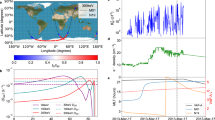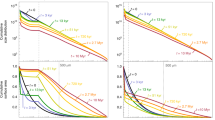Abstract
Almost all meteorites come from asteroids, but identifying their specific parent bodies, and modelling their transport to the Earth, has proved to be difficult1,2. The usual model1,3,4 of delivery through orbital resonances with the major planets5,6 has recently been shown7,8,9,10 to deplete the supply of meteorites much too rapidly to explain either the observed flux at the Earth, or the length of time the meteorites have spent in space (as measured by cosmic-ray exposure ages). Independently, it has been found that a force arising from anisotropically emitted thermal radiation from asteroidal fragments (the ‘Yarkovsky effect’) influences the fragments' orbits in important ways11,12,13,14. Here we report the results of a detailed model for the transport of meteorites to the Earth, which includes the Yarkovsky effect and collisional evolution of the asteroidal fragments. We find that the Yarkovsky effect significantly increases the efficiency of the delivery of meteorites to the Earth, while at the same time allowing a much wider range of asteroids to contribute to the flux of meteorites. Our model also reproduces the observed distribution15,16 of cosmic-ray exposure ages of stony meteorites.
This is a preview of subscription content, access via your institution
Access options
Subscribe to this journal
Receive 51 print issues and online access
$199.00 per year
only $3.90 per issue
Buy this article
- Purchase on Springer Link
- Instant access to full article PDF
Prices may be subject to local taxes which are calculated during checkout


Similar content being viewed by others
References
Farinella, P., Gonczi, R., Froeschlé, Ch. & Froeschlé, C. The injection of asteroid fragments into resonances. Icarus 101, 174–187 (1993).
Wetherill, G. W. & Chapman, C. R. in Meteorites and the Early Solar System (eds Kerridge, J. F. & Matthews, M. S.) 35–67 (Univ. of Arizona Press, Tucson, 1988).
Greenberg, R. & Chapman, C. R. Asteroids and meteorites—Parent bodies and delivered samples. Icarus 55, 455–481 (1983).
Wetherill, G. W. Asteroidal source of ordinary chondrites. Meteoritics 20, 1–22 (1985).
Wisdom, J. Meteorites may follow a chaotic route to Earth. Nature 315, 731–733 (1985).
Scholl, H. & Froeschlé, Ch. The ν6 secular resonance region near 2 AU: A possible source of meteorites. Astron. Astrophys. 245, 316–321 (1991).
Farinella, P. et al. Asteroids falling into the Sun. Nature 371, 314–317 (1994).
Migliorini, F. et al. Vesta fragments from ν6 and 3:1 resonances: Implications for V-type NEAs and HED meteorites. Meteor. Planet. Sci. 32, 903–916 ( 1997).
Gladman, B. J. et al. Dynamical lifetimes of objects injected into asteroid belt resonances. Science 277, 197– 201 (1997).
Morbidelli, A. & Gladman, B. Orbital and temporal distributions of meteorites originating in the asteroid belt. Meteor. Planet. Sci. 33, 999–1016 (1998).
Farinella, P., Vokrouhlický, D. & Hartmann, W. K. Meteorite delivery via Yarkovsky orbital drift. Icarus 132, 378– 387 (1998).
Hartmann, W. K. et al. Reviewing the Yarkovsky effect: New light on the delivery of stones and irons from the asteroid belt. Meteor. Planet. Sci. 34, A161–A168 ( 1999).
Bottke, W. F., Rubincam, D. P. & Burns, J. A. Dynamical evolution of main belt meteoroids: Numerical simulations incorporating planetary perturbations and Yarkovsky thermal forces. Icarus 145, 301–331 (2000).
Vokrouhlický, D. A complete linear model for the Yarkovsky thermal force on spherical asteroid fragments. Astron. Astrophys. 344, 362– 366 (1999).
Marti, K. & Graf, T. Cosmic-ray exposure history of ordinary chondrites. Annu. Rev. Earth Planet. Sci. 20, 221–243 (1992).
Welten, K. C. et al. Cosmic-ray exposure ages of diogenites and the recent collisional history of the HED parent body/bodies. Meteor. Planet. Sci. 32, 891–902 (1997).
Farinella, P. & Vokrouhlický, D. Semimajor axis mobility of asteroidal fragments. Science 283, 1507 –1510 (1999).
Vokrouhlický, D., Milani, A. & Chesley, S. R. Yarkovsky effect on small near-Earth asteroids: Mathematical formulation and examples. Icarus (in the press).
Migliorini, F. et al. Surface properties of (6) Hebe: A possible parent body of ordinary chondrites. Icarus 128, 104– 113 (1997).
Gaffey, M. J. & Gilbert, S. L. Asteroid 6 Hebe: The probable parent body of the H-type ordinary chondrites and the IIE iron meteorites. Meteor. Planet. Sci. 33, 1281– 1295 (1998).
Presley, M. A. & Christensen, P. R. Thermal conductivity measurements of particulate materials. J. Geophys. Res. 102, 6535–6550 ( 1997).
Yomogida, K. & Matsui, T. Physical properties of ordinary chondrites. J. Geophys. Res. 88, 9513– 9533 (1983).
Gladman, B., Michel, P. & Froeschlé, Ch. The near-Earth object population. Icarus 146, 176–189 ( 2000).
Haack, H., Farinella, P., Scott, E. R. D. & Keil, K. Meteoritic, asteroidal and theoretical constraints on the 500 Ma disruption of the L chondrite parent body. Icarus 119, 182–191 (1996).
Schmitz, B., Peucker-Ehrenbrink, B., Lindström, M. & Tassinari, M. Accretion rates of meteorites and cosmic dust in the early Ordovician. Science 278, 88–90 ( 1997).
Wetherill, G. W. Multiple cosmic-ray exposure ages of meteorites. Meteoritics 15, 386–387 (1980).
Herzog, G. F. et al. Complex exposure histories for meteorites with “short” exposure ages. Meteor. Planet. Sci. 32, 413–422 (1997).
Graf, T. & Marti, K. Collisional history of H chondrites. J. Geophys. Res. 100, 21247– 21263 (1995).
Binzel, R. P. & Xu, S. Chips off of asteroid 4 Vesta—Evidence for the parent body of basaltic achondrite meteorites. Science 260, 186–191 ( 1993).
Acknowledgements
This Letter is dedicated to the memory of P.F., who passed away on 25 March 2000. Our understanding of the role of the Yarkovsky effect in the history of the Solar System is only one of many contributions by P.F. to modern planetology. We thank J. A. Burns and C. R. Chapman for comments on the manuscript.
Author information
Authors and Affiliations
Rights and permissions
About this article
Cite this article
Vokrouhlický, D., Farinella, P. Efficient delivery of meteorites to the Earth from a wide range of asteroid parent bodies. Nature 407, 606–608 (2000). https://doi.org/10.1038/35036528
Received:
Accepted:
Issue Date:
DOI: https://doi.org/10.1038/35036528
This article is cited by
-
Unique evidence of fluid alteration in the Kakowa (L6) ordinary chondrite
Scientific Reports (2022)
-
Interplanetary Dust, Meteoroids, Meteors and Meteorites
Space Science Reviews (2019)
-
The common origin of family and non-family asteroids
Nature Astronomy (2018)
-
On the Evolution of Comets
Space Science Reviews (2015)
-
Capture probability in the 3:1 mean motion resonance with Jupiter: an application to the Vesta family
Celestial Mechanics and Dynamical Astronomy (2014)
Comments
By submitting a comment you agree to abide by our Terms and Community Guidelines. If you find something abusive or that does not comply with our terms or guidelines please flag it as inappropriate.



